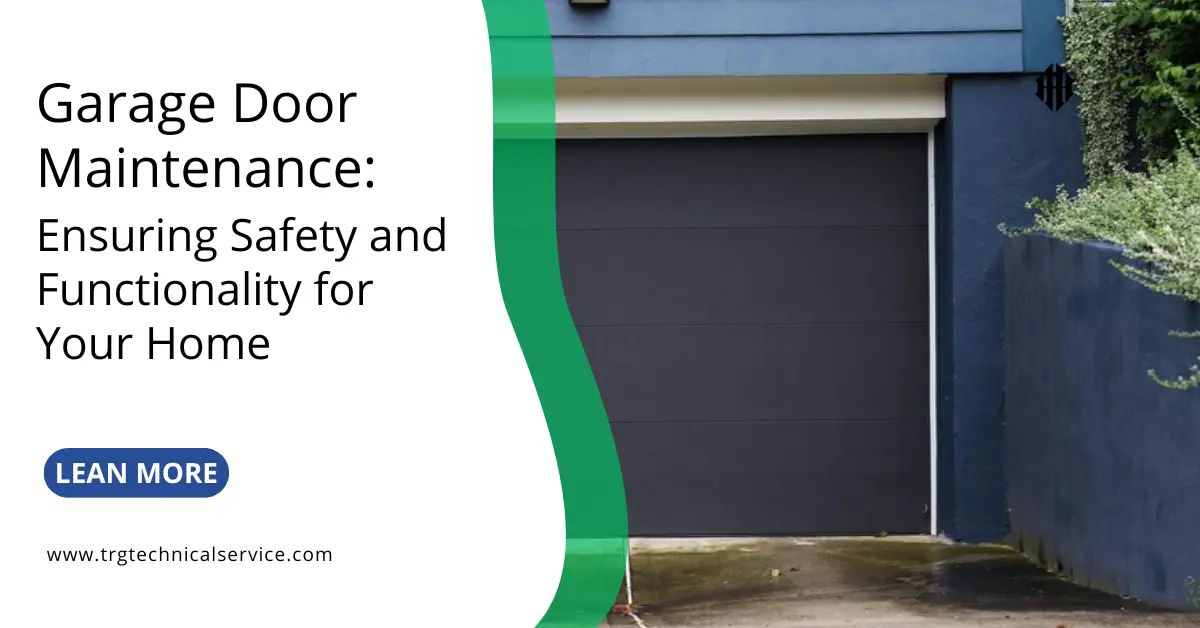Garage Door Maintenance: Ensuring Safety and Functionality for Your Home

Your garage door is often the largest moving part of your home, serving as a critical gateway that provides access, security, and protection. Given its pivotal role, maintaining your garage door is essential not only for convenience but also for ensuring safety and preventing costly repairs.
This comprehensive guide will delve into every aspect of garage door maintenance, from routine upkeep to troubleshooting, so you can keep your door in top condition for years to come.
Understanding Your Garage Door System
Before diving into maintenance tips, it’s crucial to understand the components of your garage door system. A typical garage door system comprises several key parts:
1. Door Panels: The main sections of the door, often made from materials like steel, wood, fiberglass, or aluminum. These panels can be single or multiple sections, depending on the door’s design.
2. Tracks: These are the metal rails that guide the door as it opens and closes. The tracks are mounted on the sides of the door frame and play a crucial role in ensuring smooth operation.
3. Rollers: Small wheels that run along the tracks to help the door move smoothly. Rollers can be made of steel, nylon, or plastic, each with its advantages and drawbacks.
4. Springs: There are two types of springs used in garage doors—torsion springs and extension springs. Torsion springs are mounted above the door, while extension springs are located on the sides. These springs are essential for counterbalancing the door’s weight, making it easier to lift.
5. Cables: Steel cables that connect to the springs and help lift the door. They are under significant tension and need to be inspected regularly for wear.
6. Opener: The motorized unit that powers the door. It can be chain-driven, belt-driven, or screw-driven, each type offering different levels of noise and durability.
7. Sensors: Safety features located near the bottom of the door tracks. These sensors detect obstructions in the door’s path and prevent it from closing if something is in the way.
Routine Maintenance Tasks
1. Regular Inspections
Regular inspections help identify potential issues before they become major problems. Follow these steps for a thorough inspection:
Visual Check: Examine the door panels for any visible signs of damage, such as dents, cracks, or rust. Look at the tracks to ensure they are clear of debris and properly aligned.
Check Alignment: Ensure that the door is properly aligned within the tracks. If the door seems off-center, it might indicate a problem with the tracks or rollers.
Inspect the Springs: Look for any signs of wear or damage on the springs. They should be free of rust and operate smoothly.
2. Cleaning
Keeping your garage door clean is essential for maintaining its appearance and functionality. Here’s how to clean various parts of your garage door:
Door Surface: Use a mild detergent and water to clean the door’s surface. For metal doors, a car wash soap is effective, while wooden doors may require a gentle wood cleaner. Avoid using abrasive cleaners or scrubbers that could damage the finish.
Tracks and Rollers: Wipe down the tracks and rollers with a damp cloth to remove any dirt or grime. Be sure to dry these components thoroughly to prevent rust.
Opener: Clean the opener unit with a soft cloth. Avoid using excessive moisture near electrical components.
3. Lubrication
Lubrication is crucial for smooth operation and longevity. Follow these tips for effective lubrication:
Rollers: Apply a silicone-based or lithium-based lubricant to the rollers. Avoid using oil-based lubricants as they can attract dust and dirt.
Tracks: Lightly lubricate the tracks with a silicone spray, but be careful not to overapply, as excess lubricant can attract dirt.
Hinges and Springs: Apply lubricant to the hinges and springs to ensure they operate smoothly. For springs, a specialized garage door lubricant is best.
4. Spring Tension
Springs are under a lot of tension and are crucial for the proper functioning of your garage door. Here’s how to manage spring tension:
Adjusting Torsion Springs: Torsion springs are located above the door and should be adjusted by a professional. Incorrect adjustment can lead to malfunction or damage.
Checking Extension Springs: Extension springs are located on the sides of the door. If they appear loose or too tight, consult a professional to adjust them.
Safety Checks
Ensuring the safety of your garage door system is paramount. Here are some essential safety checks:
Test the Reversal Mechanism: Place a small object (like a roll of paper towels) in the path of the closing door. When the door hits the object, it should reverse direction immediately. If it doesn’t, the safety sensors might need adjustment or replacement.
Inspect Safety Sensors: Ensure that the sensors at the bottom of the tracks are aligned properly and free of obstructions. Clean the sensor lenses with a soft, dry cloth.
Check Auto-Reverse Function: This feature prevents the door from closing on objects or people. Test this feature by placing an object in the door’s path and ensuring the door reverses when it comes into contact with the object.
Ensure Proper Function of Manual Release: Familiarize yourself with the manual release mechanism in case you need to operate the door manually during a power outage. Ensure that it functions smoothly and can be easily accessed.
Troubleshooting Common Issues
Despite regular maintenance, you might encounter some issues with your garage door. Here’s how to troubleshoot common problems:
1. Door Won’t Open or Close
Check the Power Source: Ensure that the opener is plugged in and that the circuit breaker hasn’t tripped.
Inspect Remote Batteries: Replace the batteries in your remote if the door doesn’t respond.
Examine the Opener: Verify that the opener is functioning correctly and that the settings are correct.
2. Strange Noises
Grinding or Squeaking: These noises can indicate a need for lubrication. Apply lubricant to the rollers, hinges, and tracks.
Rattling: Check for loose bolts or hardware and tighten them as needed.
3. Door Off Track
Misaligned Tracks: If the door is off track, it might be due to misalignment. Gently guide the door back onto the track and check for any damaged components. If you’re unsure, call a professional for repairs.
4. Remote Not Working
Battery Issues: Replace the batteries in the remote control.
Interference: Ensure there are no obstructions or sources of interference between the remote and the opener.
When to Call a Professional
While many maintenance tasks can be handled on your own, some issues require professional expertise. Here are situations when you should call a professional:
1. Spring Replacement: Springs are under high tension and can be dangerous to handle. Always consult a professional for spring repairs or replacements.
2. Major Repairs: If you notice significant damage to the door, tracks, or opener, a professional can assess the situation and perform necessary repairs.
3. Complex Adjustments: For intricate adjustments or if the door requires realignment, professional assistance ensures the job is done correctly and safely.
Seasonal Maintenance Tips
Maintaining your garage door isn’t a one-time task; it requires regular upkeep throughout the year. Here are some seasonal maintenance tips:
1. Spring: Perform a thorough inspection after the winter months. Check for any damage caused by snow or ice, and ensure that the door operates smoothly.
2. Summer: High temperatures can affect the door’s components. Check for any issues caused by heat and ensure that the door remains properly lubricated.
3. Fall: Before winter arrives, inspect the door for any damage and address issues such as worn-out seals or insulation.
4. Winter: Cold temperatures can impact the door’s operation. Ensure that the door and opener are functioning properly and clear any snow or ice from the tracks.
Enhancing Garage Door Efficiency
Consider these additional steps to enhance the efficiency and security of your garage door:
1. Upgrade to a Smart Opener: Modern smart garage door openers allow you to control your door remotely via smartphone apps, providing added convenience and security.
2. Install Weatherstripping: Proper weatherstripping helps insulate your garage, reducing energy costs and protecting against the elements.
3. Regular Professional Inspections: Schedule annual inspections with a professional to catch any potential issues early and ensure that all components are functioning optimally.
Conclusion
Maintaining your garage door is essential for ensuring safety, functionality, and longevity. By following routine inspection, cleaning, lubrication, and safety checks, you can keep your door operating smoothly and efficiently. Regular professional maintenance and timely repairs will also prevent major issues and extend the lifespan of your garage door system.
Remember, while DIY maintenance is important, certain aspects of garage door care, such as spring adjustments and major repairs, should always be handled by professionals to ensure safety and optimal performance. With proper care and attention, your garage door will continue to provide reliable service, enhancing the security and convenience of your home for years to come.


 Next Post
Next Post